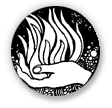

 |
|
 |
||
|
Numerous images appeared within the covers of al-Funun over the course of its lifetime. A significant number of them were drawings from Kahlil Gibran’s and Ephraim Moses Lilien’s pens. The majority of paintings that appeared in the journal were western in orientation, such as Vasillii Vereshchagin’s painting “The Apotheosis of War,” and those by Eugène Carrière (Winter), Eugène Delacroix (Rescuing The Survivors), Arnold Böcklin (The Plaque) and George Frederick Watts (Hope). The artistic style that dominated al-Funun was Symbolism. This was due to the fact that al-Funun appeared near the end of the Symbolism movement in both Europe and Russian. Al-Funun in many ways was a symbolist journal, in that Symbolism strove to depict life in allegorical terms. Symbolist artists wanted to create their own myths—or worlds of reality.1 Nasib and al-Funun’s contributors wanted to confront the deeply ingrained prejudices of their fellow emigrants against those of a different sect or religion in the Arab-American community. Consequently, they felt that Symbolism permitted them the ability to create allegories that would influence their fellow Arab-Americans towards a more “encompassing viewpoint,” since “reason’s logic” extinguishes no fires in the hearts of impassioned individuals. A number of photographs appeared in al-Funun, too. These photographs were of Gibran, Rihani, and scenes from Syria on the whole. The following examples appeared in al-Funun during its lifetime.
Humor Page, al-Funun 1, no. 3 (June 1913) Title Page, al-Funun 3, no. 5 (May 1917) Special Edition, al-Funun 2, no. 5 (October 1916) al-Naurah
in Hamah, Syria, Photograph, al-Funun 1,
Kahlil
Gibran, Photograph, al-Funun 1, no. 1 (April
Amin
al-Rihani, Photograph, al-Funun 1, no. 7
Abu
Nuwas, Drawing by Kahlil Gibran al-Funun 2,
al-Husayn
al-Awwal, Drawing by Kahlil Gibran,
al-Khansa’,
Drawing by Kahlil Gibran, al-Funun 2,
| al-Funun | Table
of Contents | Nasib Aridah
| |
|||||||||
Return
to Top
of Page